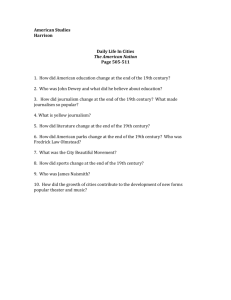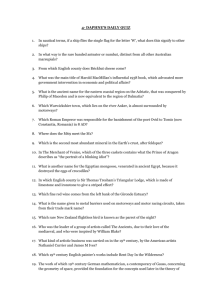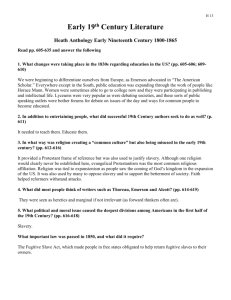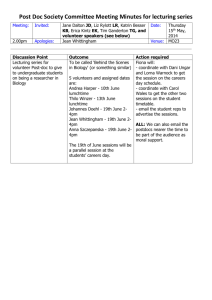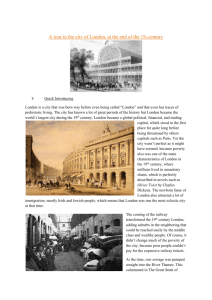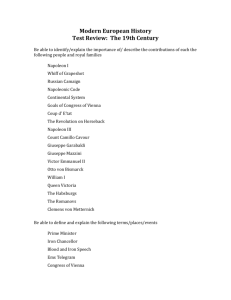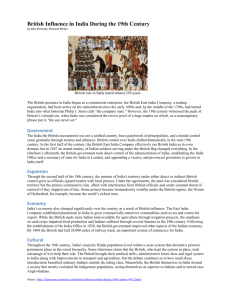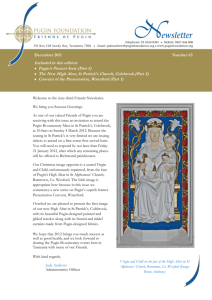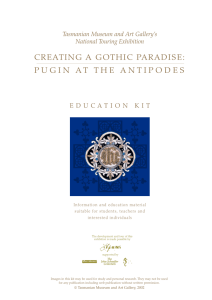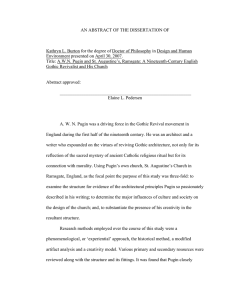ACH1702B
advertisement
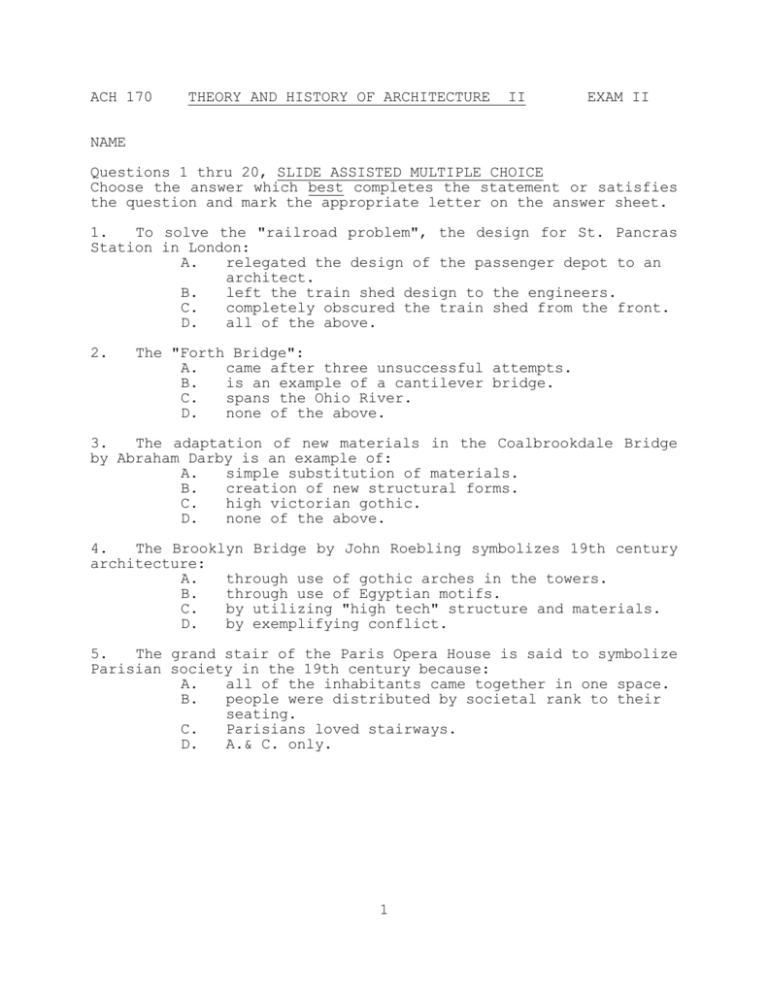
ACH 170 THEORY AND HISTORY OF ARCHITECTURE II EXAM II NAME Questions 1 thru 20, SLIDE ASSISTED MULTIPLE CHOICE Choose the answer which best completes the statement or satisfies the question and mark the appropriate letter on the answer sheet. 1. To solve the "railroad problem", the design for St. Pancras Station in London: A. relegated the design of the passenger depot to an architect. B. left the train shed design to the engineers. C. completely obscured the train shed from the front. D. all of the above. 2. The "Forth Bridge": A. came after three unsuccessful attempts. B. is an example of a cantilever bridge. C. spans the Ohio River. D. none of the above. 3. The adaptation of new materials in the Coalbrookdale Bridge by Abraham Darby is an example of: A. simple substitution of materials. B. creation of new structural forms. C. high victorian gothic. D. none of the above. 4. The Brooklyn Bridge by John Roebling symbolizes 19th century architecture: A. through use of gothic arches in the towers. B. through use of Egyptian motifs. C. by utilizing "high tech" structure and materials. D. by exemplifying conflict. 5. The grand stair of the Paris Opera House is said to symbolize Parisian society in the 19th century because: A. all of the inhabitants came together in one space. B. people were distributed by societal rank to their seating. C. Parisians loved stairways. D. A.& C. only. 1 6. The concept of three theaters as applied to Garnier's design for the Paris Opera House refers to: A. stage, audience, and academy. B. entry, seating, and circulation. C. the three major seating areas within the auditorium. D. none of the above. 7. The conflict present in 19th century architecture is manifested in the design of the plan of the Houses of Parliament in that: A. no one in England liked classicism. B. it belies the gothic detailing of the exterior. C. Pugin and Barry fought constantly. D. none of the above. 8. In his design for the Bibliothesque St. Genevieve, Henry Labrouste sought to: A. develop the structural capacity of carbon steel. B. use iron for decorative purposes only. C. mimic the design of railroad stations. D. all of the above. 9. In the design of the Gare de l'est, Duquesnay used the historicist symbolism of the gothic rose window: A. to depict trains as the mothers of invention. B. to depict afterlife experience. C. to represent the train sheds beyond. D. none of the above. 10. The influence of Etienne Boullee is seen in the Arc de Triomphe de L'Etoile by Jean Therese Chalgrin through: A. the use of classical decoration. B. the lack of polychromy on the classical elements. C. placement as a major focal point in the redesigned street system of Paris. D. the imposing scale of the structure. 11. Two of the "railroad" icons discussed in class evident on the facade of King's Cross Station are: A. the twin towers. B. the arched windows and the twin towers. C. the loggia and the clock. D. the clock and the twin towers. 2 12. The Anglican Church had as their main goal through the incorporation of dense polychromy in churches such as All Saints by William Butterfield: A. to discourage members from performing factory work. B. to include "catholicism" in their beliefs. C. to incorporate the ideas of Ruskin into their religious doctrine. D. none of the above. 13. In the eyes of A.N.W. Pugin, A. there was no appropriate style of architecture for England. B. gothic architecture was limited in application. C. England should embrace the ideas of the industrial revolution. D. none of the above. 14. Viollet-le-Duc sought to: A. develop a new aesthetic for 19th century construction through the study of gothic principles. B. prove the inappropriateness of Ecole of Beaux Arts education. C. keep the development of architectural design evolution in step with current technology. D. all of the above. 15. Among the reasons for the replanning of the street system of Paris in the mid 19th century by Haussman were: A. to clog circulation. B. to eliminate places to promenade. C. to encourage mob fighting. D. none of the above. 16. In order concerning his Eiffel: A. B. C. D. 17. to appease the demands of the general public design for a tower at the Paris exposition of 1889, added an elevator. eliminated a stairway. made it shorter. none of the above. The Statue of Liberty by Eiffel and others: A. is constructed of wooden timbers. B. is an example of the creation of new structural forms. C. uses connections designed for other materials. D. all of the above. 3 18. The "loft building" developed in the 19th century such as the Haughwaut Building: A. was a multi-use building. B. was the forerunner to the "skyscraper". C. often had cast-iron facades. D. all of the above. 19. John Ruskin, in his works such as The Stones of Venice, sought to: A. encourage people to move to Venice. B. put forth the idea that ornamentation was the most important aspect of architectural design. C. discredit the ancient architects of pallazzo design. D. all of the above. 20. Ideas inherent in the design of the Crystal Palace by Joseph Paxton include: A. modular construction. B. repetitive patterns. C. historicism. D. A.& B. only. Questions 21 - 30, MULTIPLE CHOICE AND TRUE/FALSE. Choose the answer which best completes the statement or satisfies the question and mark the appropriate letter on the answer sheet. 21. The development of ferro-concrete was aided by: A. the relative price of concrete. B. the introduction of iron bars where necessary. C. the opening of discount building supply houses. D. A. & B. above. 22. Engineering statics were based on: A. Newton's laws of physics. B. the use of electricity in buildings. C. the status of train transportation in the 19th century. D. all of the above. 23. The philosophy of Hegalianism prevalent in the 19th century had as a basis the idea that: A. man was now a "worthy" being. B. eclecticism was the most appropriate architectural style for the 19th century. C. reality and truth could only be found through process, history, and conflict. D. all of the above. 4 24. Examples of conflict present in 19th architecture include: A. the "battle of the styles". B. functional needs vs. historicist forms. C. new materials vs. traditional tastes. D. all of the above. 25. The rise of the new middle class was manifested in structures such as: A. the Houses of Parliament. B. the Paris Opera House. C. the Brooklyn Bridge. D. all of the above. 26. "Bridge" construction as relates to 19th century construction, refers to: A. advancements in dental technology. B. only structures that cross bodies of water. C. all iron skeletal structures that utilized the new building technology. D. none of the above. 27. In his book Contrasts, A.W.G.N. Pugin: A. praised the modern age. B. advocated the interment of the indigent. C. lashed out at the industrial age. D. praised punishment of debtors. 28. Pugin's design idea of "radical functionalism" holds the idea that: A. only revolutionary building designs can save mankind. B. buildings should be designed as a maze of spaces. C. decoration is the only important aspect of a building. D. building forms should be derived from their necessary functions. 29. Technological developments during the 19th century that contributed the introduction of new building materials include: A. post and lintel construction. B. the roriczer series. C. the Bessemer process. D. the true arch. 30. Nineteenth century architecture is generally difficult to classify and is usually referred to as simply "19th century architecture". A. True. B. False. 5 Questions 31 -32. Essay (20 pt. Ea.) In responding to the questions asked, take a few moments to think about how you can best answer the question. Formulate your answer by making a quick outline if needed on the back of the test packet and remember to be specific in your response and cite examples to support your answer. 31. Compare the significance of the two contrasting views shown. 6 32. Compare the significance of the two contrasting views shown. 7
